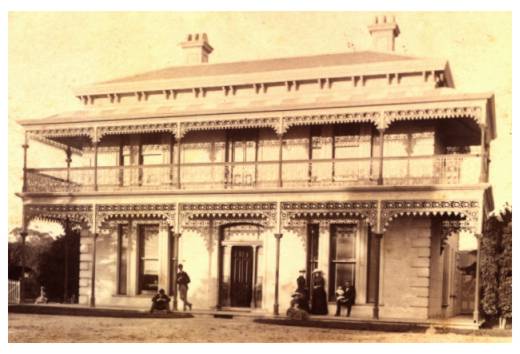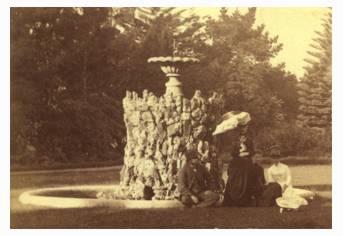William St, Balaclava (c1871 to c1887)
After leaving "The Nest", Alfred Shaw's family moved a mile or so back down Balaclava Road to William Street, close by the station. The family were to stay there for the next 17 years.
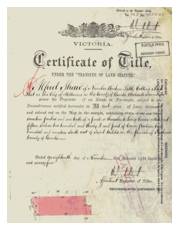 Herbert Shaw's 1949 letter to Dr. Cameron of "Nettalie" describes his father's purchase of "the Capua Villa, on a block of land about 8 acres facing William St Balaclava, from the then Italian Consul. It was an existing orchard then and also had a fair frontage to Hotham St ...". Land titles confirm that in 1871 Alfred Shaw took over about an acre of land on what is now the south side of The Avenue running back from Hotham Street. In 1874 he completed the purchase of an adjoining seven acres giving him ownership of both sides of the current Avenue bar a bit less than two acres on the northern Hotham Street corner. It is almost certain that he occupied the larger block from about 1871 when the Sands & McDougall directory showed his residence as William St, St Kilda. He purchased the second block from Heinrich Leopold Wagner who in 1868 was described as " ..of Lonsdale Street West .... , Jeweller". Could he also have acted as the Italian consul? It is interesting to note that the Austrian Consul and businessman (FN: various refs to Lange and Thoneman NZ, Tas, Vic), Emil Thoneman, had a house close by in Brighton Road at around this time (FN: S&M 1869-1870).
Herbert Shaw's 1949 letter to Dr. Cameron of "Nettalie" describes his father's purchase of "the Capua Villa, on a block of land about 8 acres facing William St Balaclava, from the then Italian Consul. It was an existing orchard then and also had a fair frontage to Hotham St ...". Land titles confirm that in 1871 Alfred Shaw took over about an acre of land on what is now the south side of The Avenue running back from Hotham Street. In 1874 he completed the purchase of an adjoining seven acres giving him ownership of both sides of the current Avenue bar a bit less than two acres on the northern Hotham Street corner. It is almost certain that he occupied the larger block from about 1871 when the Sands & McDougall directory showed his residence as William St, St Kilda. He purchased the second block from Heinrich Leopold Wagner who in 1868 was described as " ..of Lonsdale Street West .... , Jeweller". Could he also have acted as the Italian consul? It is interesting to note that the Austrian Consul and businessman (FN: various refs to Lange and Thoneman NZ, Tas, Vic), Emil Thoneman, had a house close by in Brighton Road at around this time (FN: S&M 1869-1870).
"Capua Villa"
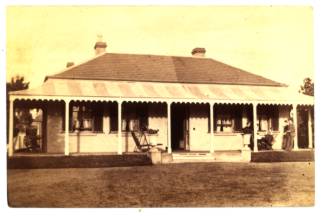 The 1873 "Vardy Plan" shows only one house on the William Street end of the block and this is almost certainly the "Capua Villa". Shaw albums contain two photographs of the house, one captioned "Capua Villa" by Lavinia Shaw and the other shown on the left. An auction notice in the Argus of 9 Oct 1869 describes the house as "Leopold Wagner's Capua Villa,the beautifully finished cemented brick residence, with slate roof & verandah front & back, in William St, East St Kilda. Drawing room, dining room, breakfast & sitting rooms, butler's pantry, entrance hall 8ft wide, 3 servants' rooms etc. On 7 acres of which 4 acres has been laid out in orchard, kitchen & flower gardens, vineyard, croqet lawn, carriage drive & walks, all laid out in the most exquisite taste. Artificial pond teeming with gold fish, & 2 handsome fountains to which the Yan Yean can be supplied, as pipes are laid all over the house & grounds."
The 1873 "Vardy Plan" shows only one house on the William Street end of the block and this is almost certainly the "Capua Villa". Shaw albums contain two photographs of the house, one captioned "Capua Villa" by Lavinia Shaw and the other shown on the left. An auction notice in the Argus of 9 Oct 1869 describes the house as "Leopold Wagner's Capua Villa,the beautifully finished cemented brick residence, with slate roof & verandah front & back, in William St, East St Kilda. Drawing room, dining room, breakfast & sitting rooms, butler's pantry, entrance hall 8ft wide, 3 servants' rooms etc. On 7 acres of which 4 acres has been laid out in orchard, kitchen & flower gardens, vineyard, croqet lawn, carriage drive & walks, all laid out in the most exquisite taste. Artificial pond teeming with gold fish, & 2 handsome fountains to which the Yan Yean can be supplied, as pipes are laid all over the house & grounds."
(Old) "Hiawatha"
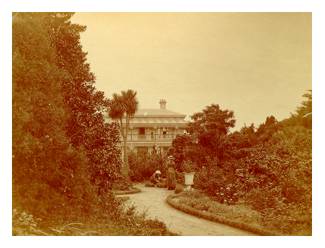 Around 1884 another house was built on this property. There are quite a few Shaw album photos showing the William Street residence and based on the mourning bands worn by the children most can be dated to just after the death of Alfred's wife Hannah in August 1884. This house was considerably more substantial than the "Capua Villa". A lavish description is provided by an auction notice placed in the Argus by Munro and Baillieu in November 1887 for "'Hiawatha' ..... the Late Residence of Alfred Shaw Esq., beautifully laid out grounds having extensive frontage to The Avenue, Hotham & William Streets .... comprising one or four acres ....erected about two and half years ago.... ".
Around 1884 another house was built on this property. There are quite a few Shaw album photos showing the William Street residence and based on the mourning bands worn by the children most can be dated to just after the death of Alfred's wife Hannah in August 1884. This house was considerably more substantial than the "Capua Villa". A lavish description is provided by an auction notice placed in the Argus by Munro and Baillieu in November 1887 for "'Hiawatha' ..... the Late Residence of Alfred Shaw Esq., beautifully laid out grounds having extensive frontage to The Avenue, Hotham & William Streets .... comprising one or four acres ....erected about two and half years ago.... ".
So where exactly was this new house built? We know from a photograph held by the State Library of Victoria that "Hiawatha" was still standing in 1904. An 1898 MMBW Plan shows what is sure to be the house on a one or two acre block in roughly the same location as the "Capua Villa" on the 1873 Vardy plan. It may be stretching the accuracy of these maps but the relative positions suggest that "Hiawatha" was built onto the front of the earlier house. It's only a theory but considering that the "Capua Villa" was a solid house probably little more than twenty years old at the time it would make sense.
Arcadia
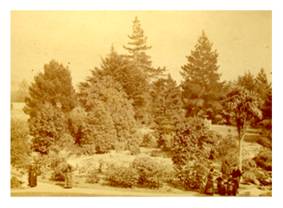 For Alfred whose childhood had been spent in the overcrowded bustling centre of that grey northern town Huddersfield this must have seemed an idyllic existence. His eight children, watched over by their nurse "Teeny", had the run of orchard, dairy farm, stables and formal parkland. As if this wasn't enough, Hannah's sister Sarah's family including four similarly aged children lived next door. Her husband Hugh Roberts Thomas owned a house facing Carlisle Street on an adjoining eight acre block (blocks 18 to 20 on the 1873 Vardy Plan).
For Alfred whose childhood had been spent in the overcrowded bustling centre of that grey northern town Huddersfield this must have seemed an idyllic existence. His eight children, watched over by their nurse "Teeny", had the run of orchard, dairy farm, stables and formal parkland. As if this wasn't enough, Hannah's sister Sarah's family including four similarly aged children lived next door. Her husband Hugh Roberts Thomas owned a house facing Carlisle Street on an adjoining eight acre block (blocks 18 to 20 on the 1873 Vardy Plan).
Over Carlisle Street and a little way up William Street's extension, Blenheim Street, lived Benjamin Hill, his wife Mary and six children. It is likely that Benjamin, an ironmonger, was an employee or at least a business associate of Alfred Shaw but it is certain that the children were close to the Shaw children. Lavinia Shaw's album contains a number of photographs of the eldest, Emma Hill, who was of a similar age to Lavinia and Ernest. The youngest Hill children, Mabel and Ernie, also appear in the albums.
Not far away in Tivoli Place South Yarra, just a few stations up the railway line, was the family of Hannah's older sister, Mary. The two families appear to have been close. Her husband John Clarke and some of their six sons appear often in the family albums from this time. It was to the Clarkes that Hannah went during the time of son Luther's illness and it is likely that Hannah and Mary's mother Dinah Turton lived with the Clarkes for some years before her death in Oct 1884, two months after that of Hannah.
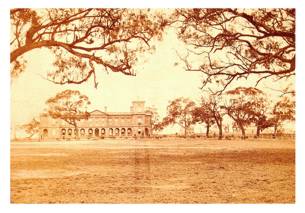 With Balaclava Station virtually next door, the railway would also have been used by the Shaw boys who started at Wesley College in 1872 (Alfred and Arthur), 1873 (Ernest) and 1884 (Herbert - why so late?). In the albums there are a number of photographs of Fred Vail probably a school friend of Ernest. It would be interesting to know whether the uniform he is wearing is an 1870s Wesley College uniform.
With Balaclava Station virtually next door, the railway would also have been used by the Shaw boys who started at Wesley College in 1872 (Alfred and Arthur), 1873 (Ernest) and 1884 (Herbert - why so late?). In the albums there are a number of photographs of Fred Vail probably a school friend of Ernest. It would be interesting to know whether the uniform he is wearing is an 1870s Wesley College uniform.
Herbert's 1949 letter mentions a "wooden villa" on Hotham Street and occupied "in his time" by the Robinson family of "Robinson Bros. (Metalworkers)". Herbert would almost certainly be referring to Thomas Buchanan C. Robison who lived with his family in Hotham Street from 1877 until 1883 (FN: S&M). He was a partner in the South Melbourne heavy engineering firm of "Robison Bros & Co". His sons were at Wesley College at about the same time as the Shaw boys.
1887 and moving on
1887 was the last year that Alfred Shaw's residence appeared in the Sands & McDougall directory as William Street. In 1886 he had travelled to England and remarried. In April 1887 he was back for daughter Amelia's wedding at "Hiawatha" and according to son Ernest's marriage certificate the family was still there in October. It is not clear whether "Hiawatha" sold at the November auction but by December the William Street properties were owned by John Ebenezer Gourlay who earlier that year had subdivided the adjoining 10 acre block centred on the present day Gourlay Street. By the end of 1888 The Avenue had been created, the surrounding land subdivided and most of its blocks sold. According to some real estate leaflets described on the Melbourne Mansions database "Hiawatha" was still standing in the early 1920s when it was probably demolished to make way for subdivision. A block of flats now stands on the home block.
There are indications that for a brief period in 1888 Hiawatha was the first location of Sacre Cœur girls' school and a school history published in the 1970s refers to it being purchased from a Mr Shaw. Certainly by the beginning of that year the Shaws were well established in a new Hiawatha in Brighton.
Eerily, in 2003 when Herbert Shaw's great granddaughter was renovating her house in The Avenue (now also named "Hiawatha") the builders found what seemed to be the remains of water pipes and a circular concrete fountain base. Judging by the location it was what was left of the fountain that appeared in many of the early photos of Hiawatha.
